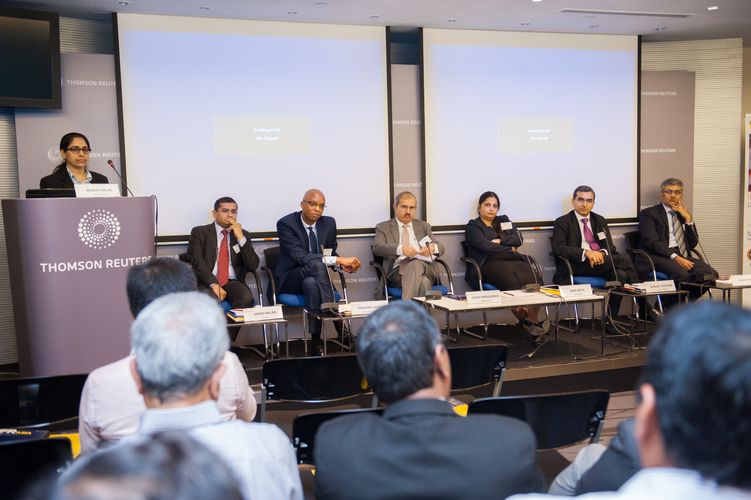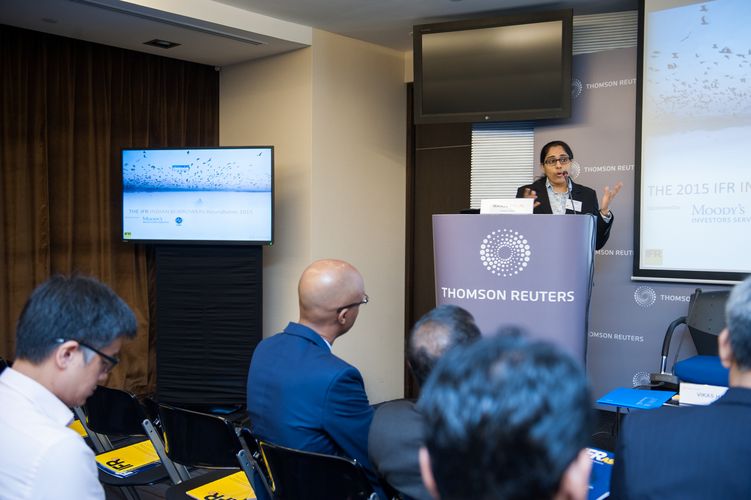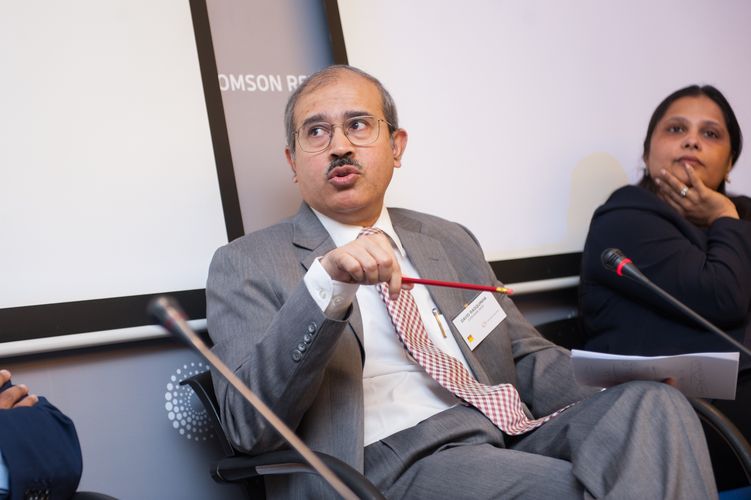IFR: Interesting point. RBI has not allowed Indian banks to tap the Masala bond market, for AT1s. But they should probablydo that.
Sanjay Guglani, Silverdale Capital: Masala bonds are too hot for us. My investors are US dollar-denominated investors. If I were to buy NTPC bonds at 8%-8.5% and hedge I would make about 2%-ish. As of yesterday evening, NTPC’s July 21 bond was giving me 3.61%. I dare not go there.
As Nipa said, there is appetite for long duration local currency bonds. And as correctly pointed out, the right people to do a Masala bond are those who can diversify their investor base rather than benefit on rates. That’s a key thing.
On the Dim Sum points that Philippe touched on earlier, let me remind you of two very important things that allowed the market to grow something like 100-fold in three years: intent and vision. When China stared talking about the internationalisation of the yuan they went to a lot of countries and signed dual-currency pacts. That’s the intent part.
They came to Singapore and they offered us a post-hedging uplift of about 20bp-25bp. People like me flocked to it. They did billions in two and a half months. That’s the vision. Until recently, we’ve had a liquid Dim Sum market. We don’t see anything like this happening in India. Rather, the guidelines which came out were: “OK you have to run. I’ll hold both your hands and both of your legs. Now run”. There were so many restrictions out there.
Philippe Ahoua, IFC: Just to add to that, you saw the announcement regarding the Special Drawing Rights and the renminbi. The Chinese government, for all intents and purposes, had made a decision to internationalise the currency. Vikas mentioned that that is too premature in India.
So until the government of India decides that the rupee needs to be internationalised and supports that mechanism, the Masala bond market is not going to grow off of the back of the IFC, the World Bank, ADB, Triple A and other Indian corporates. You have to have the sovereign supporting the market, providing liquidity and providing a sovereign yield curve off of which pricing is going to happen, similar to what’s happening domestically in India.
Sanjay Guglani, Silverdale Capital: Beyond the requirement of formal regulation and support, which is absolutely critical, I would say the basic thing they need to do is in terms of free rupee hedging. You cannot stop me from hedging. Why pretend?
Philippe Ahoua, IFC: It’s worth mentioning that the Philippines had large funding requirements a few years ago and issued in that format in the offshore market. So you may not want to internationalise your currency but some of your domestic funding requirements could also justify some sort of internationalisation of the currency.
So there are a lot of different factors that can play into that process.
IFR: Sanjay, what is your outlook on Indian credit?
Sanjay Guglani, Silverdale Capital: I am bullish by default and by design. The reason I’m bullish by default is because when I run such a big bond fund, I need diversification so whether I love it or hate it, I need to have India paper on my books. I’m bullish by design because we see fantastic credit quality from India, and that’s partly because the sovereign is rated investment grade, at Triple B minus.
Many Indian corporates could technically be better than Triple B so when they go and try to price their securities in the international market, they’re able to get close to Triple B but not close to what would be effectively that real cost.
The other thing I am bullish about is the economy. I am passionate about India. That’s why I talk about what can be done. There is no denying that we’ve seen a huge amount of changes taking place. I firmly believe India is turning around in 2016 and 2017. The future looks bright.
IFR: How can we compare the relative costs of funding offshore versus onshore for Indian borrowers?
David Rasquinha, Export-Import Bank of India: I’ve been a bit of a sceptic on this whole issue of the natural hedge, which somebody mentioned earlier. I’ve always been a little sceptical as to whether you can use revenue flow to hedge a capital liability. And particularly in a situation like India, where your exchange rate changes are discontinuous. It’s not a smooth flow. You have sudden ups and downs.
I think the Reserve Bank is on the same page because they’ve been particularly after the banks to ensure that their clients hedge and if they don’t hedge, there is an additional provisioning requirement.
The domestic market offers enough finance. Just to give you an example: tax-free bonds. The issues that have come out so far in 2015 have been tiny but in 2014 you had bigger issues. And you have bigger issues coming up. They’ve been oversubscribed like they’re equity offerings. So there is money available whether it is in the bank market, whether it is in the wholesale market, the high net worth market, or retail, money is there for investment.
The cost of that money is one point. And equally important – and Sanjay referred to this in passing – is credibility. A typical investor wants not just a good rating but a promoter he can trust. And that is something which is very difficult to price.
Nipa Sheth, Trust Group: As I mentioned earlier, it’s not necessarily always from a cost of funding perspective. It will be a phase for some Triple A companies to access the market but capital-hungry sectors will be the ones that discover the ways and means and the right price point.
Where long-term funding is available, the internal guidelines of pension funds mean they’re restricted to funding only Double A. But for infrastructure or any long-term projects it’s almost impossible to have a Double A rating unless there is some sort of credit enhancement, which has a cost attached.
I think it will be essentially open only for where you look at a piece of capital which is not easily available. And there’s the asset liability mismatch: you may be able to get short-term funding but to get long-term funding if you’re not Double A and above is not easy.
IFR: My next question is about the high debt levels of Indian corporates. In a scenario of stressed balance sheets, volatile markets, and a tightening dollar rate environment, do you think Indian issuers will be able to cope with the growth expectations we have in terms of raising debt? You already are sitting on a lot of debt. There is no growth happening. Why would you need to borrow?
Vikas Halan, Moody’s: The background that you’ve laid out is one of high leverage: earnings that aren’t growing and high domestic interest rates resulting in lower interest coverage. And you have very little investment need.
Now, let’s the roll the clock 12 months forward. Growth is still there in India. Interest rates are down domestically. Foreign interest rates are up. You have not invested in any projects so your capex is down so whatever free cashflow you had, you’re going to use to repay the debt. The debt level goes down. Earnings go up. Your leverage should be more manageable, provided you don’t invest further.
What we have seen in the past is as soon as you have green shoots in India, you see a lot of risk-taking. People start to build capacity in anticipation so euphoria takes over, and then you have over-supply coming in. And that’s a risk that, if avoided, will see balance sheets improving and credit quality getting better.
Anjan Ghosh, ICRA: Leverage has to be broken into two parts. Overall, corporate leverage is not a concern. In fact if you look at our domestic ratings business, we have seen a fair share of upgrades in the last couple of years.
The sector that is under stress is the infrastructure sector and the large infrastructure groups. And if you look at some 13/14 of the very large and very stressed infrastructure groups, their overall debt levels have been growing at around 30%-35% over the last four/five years. Adding to the problem is the fact that of overall debt levels, more than 50% is accounted for by the power and metals sectors,the two sectors where the maximum number of stresses exist.
These are also the sectors that are totally out of favour with equity investors. Even when the equity market boomed a year or so back, we didn’t really see the stock prices in these companies going up. And this is the sector which requires the maximum amount of deleveraging and the maximum amount of equity-raising. I do not see too much equity raising happening, because investors are simply not comfortable with these areas. There would be huge issues on valuation.
Plus, the fact is a lot of structural issues have not been solved, whether it is in the power sector, whether it is in the metals sector. Of course it’s a cyclical issue, so no government can do anything about it. Equity markets may help on the margin. But it will not really take care of the problem.
IFR: Indian equity volumes in 2014 were Rs11bn. So far in 2015, we have seen more than Rs19.5bn issued. Does anybody on panel think equity offerings can strengthen the Indian credit profile?
Sanjay Guglani, Silverdale Capital: On equity financing we will see more issuance coming from India. But a lot of the issuance we’ve seen hasn’t been going towards refinancing debt. Many of the companies we’ve seen in the market have been funded by private equity looking for an exit. I’d be surprised if even half the money raised in the equity market has gone to refinancing. Most of it is a case of Investor A replacing Investor B.
Audience question: One topic we haven’t touched too much upon yet is green bonds. It’s an area that has been very large in Europe, and India has had a great start. I’m keen to hear the panel’s thoughts on how you see this sector growing, and how important it is for Indian borrowers?
David Rasquinha, Export-Import Bank of India: We had one of our big successes with the green bond we did in the first quarter of 2015. Frankly, we were surprised. We went into that deal expecting to do somewhere around US$250m-$300m. Our objective was to gain entry into the green market to diversify our investor base. Deep down, we would probably have been prepared to even look at paying a small premium. Not necessarily, but it was somewhere there in the back of our minds. To our pleasant surprise, the book started building very quickly. It included green and non-green investors.
The price intentions built to a point where we upsized to US$500m, which was not something we had in mind when we started. And we were able to get a price that was better than we had got just a month and a half previously. We were frankly surprised, because we didn’t think that such a second venture into the market in such a small space of time would have been welcomed.
It was a learning curve for us and maybe we were a bit naïve to begin with. But we were pleasantly surprised at every step of the process. What were our takeaways? We needed to do a lot more information sharing, which we were not used to. We’re used to the standard due diligence on accounting, and macroeconomics and microeconomics but for the green investor market, we had to go into depths of detail, which surprised us. We weren’t expecting those kinds of questions.
So to some extent, we probably lost a couple of green investors, because we were not fully prepared for the kind of rigour they expected. Not that we hadn’t done it but we didn’t have the data available to give them the answers.
To cut a long story short, the experience was phenomenally positive. It outpaced all of our expectations. I’m surprised that other issuers have not followed suit. IDBI did recently but I thought many others would. In fact we were rather pleased with ourselves that we’d opened the market for others. Certainly if the conditions look right, we’d be happy to go back again.
Philippe Ahoua, IFC: IFC is one of the biggest green bond issuers and we were part of the original green bond principles. In India, we supported the Yes Bank rupee green bond by funding it through the Masala green bond we did ourselves. But we’d like to see more of that happening. This is something that a lot of corporate clients that we talk to have approached us about.
With the Yes Bank transaction, we also helped establish some of the green principles and the use of funds. We’d like to partner with anybody; it’s part of our development mandate. We’re looking at it across Asia. But in India particularly, we’ve got a really big team looking at renewable energy and those types of things. That’s a target audience of funding that we’re looking at. Green bond development, both onshore and offshore, is a big deal for us.
Audience question: I just wanted to rewind back to our discussion on Masala bonds, where we talked about investors naturally being excited by it because it gives them a route to invest into India if they don’t have a FPI vehicle. Similarly from an issuer’s perspective, also it works because they unearth additional liquidity to tap into.
Now we’re close to nearly 9,000 FPIs being established for investments into India. Who are these investors that have so far have not had really an established vehicle to invest into India, but are expected to be spiced up by this Masala bond opportunity? Who are we really chasing? What are the kinds of investor class that will really come in and bring their delta?
Philippe Ahoua, IFC: There are around 9,000 investors who have got FPI licenses. Among those investors who are not part of that investor pool is, to give one example, the Teachers’ Retirement Fund of the State of Washington, which has bought into every maturity we’ve issued in Masala bonds.
Many Uridashi investors in Japan don’t have FPI licenses. I don’t know why. But huge demand is coming out of Japan for Masala bonds because traditionally Japanese investors are used to taking foreign exchange risk. They’re looking for yield and some level of currency stability. That’s exactly the story that the Masala bond offers.
So just to answer that, I wouldn’t underestimate the demand by offering something that is Euroclearable, that you can buy in Luxembourg and which is listed in London or Singapore. You’d be surprised how many people you can unearth in any currency in any format.
If you offer something in a format that people are comfortable with in terms of settlement, eventually the investor is going to take local currency exposure. But it’s settled in dollars. You can buy it on an exchange. You’ll see how many investors you unearth. And what could happen after that, is the investors will then most likely be interested in looking at getting FPI licenses so you increase your pool of potential FPI investors going forward.
IFR: Let’s wrap up the session there. A big thank you to our panellists for sharing your insights.
To see the digital version of this roundtable, please click here
To purchase printed copies or a PDF of this report, please email gloria.balbastro@thomsonreuters.com


